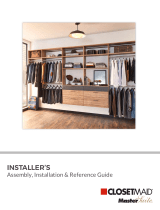Page is loading ...

38.74”
19.25”
20.67”
INSTALLATION MANUAL
SR-RACKSLIDE-300
Strong™ Metal Rack Sliding Base
Lifetime Limited Warranty
All Strong™ products have a Lifetime Limited Warranty. This warranty includes parts and labor repairs on all
components found to be defective in material or workmanship under normal conditions of use. This warranty
shall notapply to products which have been abused, modied or disassembled. Products to be repaired under
this warranty must be returned to SnapAV or a designated service center with prior notication and an
assigned return authorization number (RA).
For Techincal Support : 1.866.838.5052
Lifetime
CABLE MANAGEMENT
1. Determine direction of rack rotation and wiring plan for this direction. Select one side of rack for signal cables,
and the opposite side for power cables. Fully extend rack and rotate 90 degrees in intended direction. Lace
cables ensuring they are fairly taut. This will help ensure that the service loop will be the correct length and not
be pinched when closing the rack.
NOTE: Wiring this way will keep the rack rotation in the direction
originally selected when cabling is complete.
Cable Management Tip:
Tie your cable bundles at least every 6” - 8”. This allows cable bundles
to lay neatly together when rack is in the closed position.
DIMENSIONS
60° 90°
120529-1000
PG.3

Fig. 6
Fig. 7
Fig. 8
Fig. 9
Fig. 1
Fig. 2
Slide Lock
Fig. 3
Swivel Lock
Fig. 4
60° Rotation
Fig. 5
90° Rotation
1½“ max.
setback
2. With base partially installed, test slide and rotation operation of the base. Slide
should pull away from lower base and fully extend with Slide Lock (Fig. 2) engaging
and preventing you from pushing slide back. Next, check the swivel. Press in on Swivel
Lock (Fig. 3) and spin the top left and right. The top will self lock at 60 (Fig. 4) and 90
degree (Fig. 5) rotations. To close slide-base, press down on the Slide Lock and push
the slide-base back.
3. If operation of slide is satisfactory, Secure the base by fastening the remaining (4) lag
bolts and washers. VERY IMPORTANT - Use all the mounting points when axing the base
to the host enclosure.
ATTACHING THE RACK
The mounting method for each rack series is dierent; refer to the instructions below for the rack series being installed .
1. Pre-drill holes in oor or cabinet bottom using 1/4” drill bit. Attach the base to oor
or cabinet bottom at the two rear hole locations using (2) 2-1/2” lag bolts and washers
(Fig. 1). The Rackslide base can rest ush with the wall but must be completely at
against the oor or cabinet bottom. Should interference from surrounding millwork
occur, it may be necessary to ne tune the mounting location (remove the preliminary
mounting points and adjust as necessary).
INSTALLATION
MOUNTING THE RACK SLIDE
Maximum suggested setback of base from opening is 1 ½“ (more setback will hinder ability to rotate).
SR-CAB SERIES
1. Place the rack onto sliding base (EasyGlide™ runners MUST be
removed).
2. Align the rack towards the rear of the slide. Note that the front of the
rack will overhang the slide (Fig.6).
3. Starting with the right rear, align the rack mounting hole over the
slide plate mounting hole (Fig.7). Insert a rack screw; leave the screw
loose until nal step.
4. Align the left front rack mounting hole over the slide plate mounting
hole and insert a rack screw (Fig.8). Insert rack screws into the
remaining 2 locations in the order described in (Fig.8) and tighten all
screws.
5. Re-test operation of slide-base per Step 2 to validate (Fig. 9).
6. Once installation is completed and rack is in closed position, install
the Blank Finish Plate (B) with Assembly Screws to cover the face of
the RACKSLIDE and rack base for a cleaner nish (Fig. 13).
SR-CS-RACK SERIES
1. Place the rack onto sliding base (rack casters MUST be removed).
2. Starting on either side, remove rack assembly screws from base of the rack (Fig. 10). Next, line up (1) Rack Attachment
plate with the holes in the slide-base and holes in the rack. Using rack Assembly Screws provided, attach Rack Attachment
Plate (Fig. 11).
3. Follow same procedure for opposite side.
4. Re-test operation of slide-base per Step 2 to validate (Fig. 12).
5. Once installation is completed and rack is in closed position, install the Blank Finish Plate (A) with Assembly Screws to
cover the face of the RACKSLIDE and rack base for a cleaner nish (Fig. 13).
Fig. 10
Fig. 12
Fig. 13Fig. 11
PARTS INCLUDED:
(1) Rackslide Base
(1) Rack Attachment Plate
(2) Blank Finish Plates ( 1 for each series rack)
(2) Side Mounting Plates
(22) Assembly Screws
(6) 5/16” x 2 ½” Lag Bolts
(6) ½” Washers
(6) Concrete Anchors
TIPPING HAZARD:
Host enclosure (cabinet) MUST be adequately secured to the oor or wall. This prevents the cabinet from falling forward
when rack is pulled out. Mount 1/2 of equipment weight in lower 1/3 of rack.
NOTE: SR-CAB-8U-/10/12/14U are to be built separately and installed after
SR-RACKSLIDE-300 base is installed, allowing o-site equipment integration.
TOOLS NEEDED:
No. 2 Phillips Screwdriver
1/2” wrench
1/4” Drill Bit
WARNING: Maximum load is 300 lbs.
PG.1 PG.2
/



